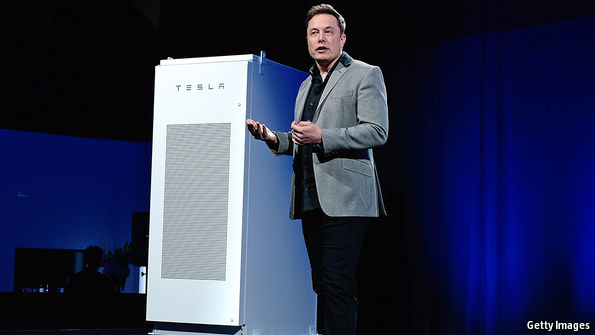
HOW much power does a tweetstorm involving two tech tycoons, the prime minister of Australia and 8.5m Twitter followers generate? Enough, at least, to supercharge a debate about the future role of batteries in the world’s energy mix.
Elon Musk, a Silicon Valley entrepreneur (pictured), may be best known for his gravity-defying ambition, but his core product is the battery: whether for his Tesla cars, for the home or for grid-scale electricity storage. He gave the last of these an unexpected jolt of publicity on March 10th, by responding to a blackout-inspired challenge on Twitter from an Australian software billionaire, Mike Cannon-Brookes. Mr Musk said he could install 100 megawatt hours (MWh) of battery storage in the state of South Australia in 100 days to help solve an energy crisis it faces, or it would be free of charge. “That serious enough for you?” he asked.
In response, Malcolm Turnbull, the prime minister, communicated with Mr Musk and appeared to turn from pro-coal sceptic into battery believer. On March 14th Jay Weatherill, the premier of South Australia, went further. Declaring that the national electricity market was “broken”, he said the state would launch its own A$550m ($415m) plan to build a 100MW battery system, as well as a gas-fired power station, with public funds. Mr Musk may have got what he wanted. He is “good at bringing nerdy subjects to a broad audience”, says Julia Attwood of Bloomberg New Energy Finance.
Are batteries now cheap enough to be a cost-effective way of solving energy crises like that in southern Australia, brought on since July by storms, heatwaves, the intermittency of solar and wind power and the closure of coal- and gas-fired power stations? The answer, says Michael Ottaviano of Carnegie Clean Energy, which is hoping to sell its own grid-scale battery systems to the state, is “no”—especially under current market structures.
True, battery prices have plummeted and Mr Musk’s price, of about $250 per kilowatt hour (kWh), is relatively cheap. But the total cost (including building the plant, for example) would be about $500 per kWh to hook the batteries up to the grid. A 100MWh facility would cost $50m. Only when power prices reach stratospheric levels would that investment make sense for a utility. That’s why the government of South Australia is having to stump up instead. Eventually, practitioners hope that changes to the power market will make battery storage viable without public funding. “This is a short-term Band-Aid until the regulatory process catches up,” Mr Ottaviano says.
But it has all sparked a discussion about batteries that will keep going (and going). On March 13th GTM, a consultancy, and the Energy Storage Association, a trade body, said that battery installations in America, led by utility-scale storage, doubled to 336MWh by the end of 2016. Much was in California, reacting to the blowout of the Aliso Canyon gas plant in 2015. At least crises aren’t going to waste: an industry is emerging.

No comments:
Post a Comment